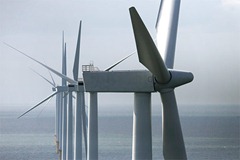 Wind is often held up as a major solution for the UK and Ireland’s energy challenges. Energy economist Professor Gordon Hughes, though, told the Northern Ireland Energy Forum that reliance on wind power will drive up costs and fail to deliver on cutting carbon emissions.
Wind is often held up as a major solution for the UK and Ireland’s energy challenges. Energy economist Professor Gordon Hughes, though, told the Northern Ireland Energy Forum that reliance on wind power will drive up costs and fail to deliver on cutting carbon emissions.
Relying on wind power will drive up energy prices without achieving major cuts in CO2 emissions,
according to a leading energy economist.
Gordon Hughes is a professor of economics at the University of Edinburgh and was, until 2001, a senior adviser on energy and environmental policies at the World Bank. His more recent work has studied the economics of renewable energy.
Hughes addressed the Northern Ireland Energy Forum on the potential impact of 40 per cent targets on the whole electricity system, based on empirical research.
Wind, he noted, is “not merely highly variable over short periods of time but it’s also variable in the medium term over a matter of days.” A corresponding back-up power system is therefore essential i.e. mainly gas in the UK and Ireland.
While interconnection was held up as a solution for the variability problem, he found that interconnectors “do not correlate at all well” with wind availability as they are driven by many other factors. Indeed, wind availability is “moderately well correlated” across the British Isles; a wind farm in Scotland is likely to have a similar wind speed to that Ireland and therefore will be unable to substitute for shortfalls there. Hughes instead proposes large scale investment in conventional energy (currently gas) to complement wind power.
The prospect of wind-dominated systems had major consequences for the future of energy investment.
“Wind power affects the structure of prices throughout the year and it dramatically affects the return that investors can expect to earn,” he commented. Gas-fired plants make most of their money during a relatively small number of hours throughout year, usually in winter, and fewer peak periods would mean a lower return on capital.
The average price received by wind generators when generating is significantly lower than the equivalent for gas. That difference (£5 per GWh in Great Britain) is enough to pay for the full capital costs of a CCGT plant and therefore removes the economic incentive to invest in gas.
Introducing more gas to the system, as a back-up fuel, would lead to greater volatility and higher costs of capital for potential investors in the supply business, where hedges have to be taken out in advance.
Increasing wind generation, he stated, would also result in a reduction of around 20 percentage points in the load factor for gas plants, which was also unattractive for investors. Wind had also historically led to the increased use of coal (relative to gas), stimulated investment in less efficient open cycle gas turbines, and reduced the market return for biomass and similar renewables which rely on steam cycles.
Hughes estimated that Ireland would need an extra 2,800MW in open cycle plant to ensure security of supply. With no incentive for investment from power generation, customers will need to pay for this through the Single Electricity Market’s capacity mechanism.
“The exact numbers are disputed because people take different views but the basic point is that you save, by having wind, much less carbon dioxide than anybody will tell you,” he told the audience. Actual savings in carbon dioxide emissions are “probably quite small” and he had concluded that wind “is just a terrible way of saving carbon dioxide.”
The target carbon floor price is £30 per tonne in 2020 but Hughes estimates that wind will cost £300-500 per tonne of CO2: “The question that comes out of that therefore is that we have to think very carefully about whether this is an effective way of reducing CO2 emissions.”
A further concern is that the performance of wind farms seems to deteriorate with age. Normalising for wind availability the average load factor for wind farms in Great Britain falls from 23.5 per cent when they are new to 15.5 per cent at age 10. As a consequence, very few wind farms will be run for more than 10-15 years.
He also finds that new wind farms are becoming less efficient: “The ones built in 2000 were better than the ones built in 2005 which were better in turn than the ones built in 2010.” The first wind farms, he notes, may have used up the best sites. Evidence from turbine performance in Denmark shows a more serious decline among offshore turbines.
In summary, the average load factor was likely to decline as the fleet of turbines gets older, which will in turn reduce actual wind generation and make it harder to meet renewable energy targets set by government.
Turning to Ireland’s targets, Hughes expects significant periods when the availability of wind power exceeds the total demand for electricity in the single market. Wind will therefore need to be curtailed during 10-15 per cent of operating hours, resulting in the loss of 5-10 per cent of potential capability which cannot be absorbed by the system.
This poses a “very difficult policy problem” i.e. should wind generators be compensated when curtailment takes place?
At present, compensation to wind operators in Britain and Ireland is set at the market price, and sometimes higher than that. The REFIT and ROCs schemes guarantee prices for wind but this is inherently unfair to conventional technologies.
“Looking at that as an economist, I think that’s an extremely odd way of proceeding,” he remarked. “It’s not the case that we compensate nuclear power operators if there’s more nuclear than they can dispatch so why should we do that for wind?”
He contrasts the “over-generous” treatment of wind power in particular with the large costs that it creates for the rest of the system. Regulators, in his view, have not yet answered the question satisfactorily.
The cost to consumers is one of the most contentious aspects of the shift towards more renewable energy. In Great Britain, Hughes expects that meeting the renewable energy target (15 per cent by 2020) will result in wholesale bills rising by 100-130 per cent and annual retail bills going up by 40-60 per cent i.e. from £550 to £750-800.
His figures are “highly disputed” by the Department of Energy and Climate Change, which anticipates lower increases which can be partially offset by better energy efficiency. However, Hughes does not see a “current willingness” among consumers to pay for that level of renewables.
“Wind is a very expensive way of saving carbon dioxide,” he concluded. “It’s much more expensive than other renewables and therefore we ought to be thinking a lot harder before we simply believe that the way to meet our renewables targets is essentially to add more and more wind to our generating system. And that’s true for Ireland as well as for the GB market.”






